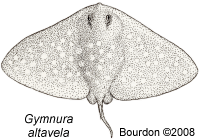| |
 The butterfly rays are circumglobal batoids found in warm temperate and sub-tropical waters of the continental and insular shelf. Two genera are recognized, Aetoplatea VALENCIENNES in Müller & Henle 1841 (Indian & western Pacific oceans) and Gymnura MÜLLER & HENLE 1837; fossil material is attributed to Gymnura. Of the twelve extant Gymnura species, two [G. altavela (LINNAEUS, 1758) and micrura (BLOCH & SCHNEIDER, 1801)] are present in the western North Atlantic. These species prefer soft bottoms and feed on fishes, crustaceans, mollusks and plankton. G. altavela is a large ray (DW to 4m) while micrura is much smaller (to 1.3m).
The butterfly rays are circumglobal batoids found in warm temperate and sub-tropical waters of the continental and insular shelf. Two genera are recognized, Aetoplatea VALENCIENNES in Müller & Henle 1841 (Indian & western Pacific oceans) and Gymnura MÜLLER & HENLE 1837; fossil material is attributed to Gymnura. Of the twelve extant Gymnura species, two [G. altavela (LINNAEUS, 1758) and micrura (BLOCH & SCHNEIDER, 1801)] are present in the western North Atlantic. These species prefer soft bottoms and feed on fishes, crustaceans, mollusks and plankton. G. altavela is a large ray (DW to 4m) while micrura is much smaller (to 1.3m).
 In Gymnura altavela, the jaws are relatively delicate and non-descript bearing numerous files (100+) and rows (12 or more) of small cuspidate teeth;1 best described as having a minimalized grasping/clutching function. In the Bigelow & Shroeder (1953) depiction of altavela tooth files, the male design is more robust than the female. Although similar to the teeth of the male Mobula hypostoma (BANCROFT, 1831), the teeth tend to be smaller, have only two root lobes, lack distinct lateral cusplets/ enlargements and most importantly have a strong medial depression of the labial crown face (ref. Fig. ). These otherwise homogeneous teeth may vary when file splitting occurs; on the right in figure , a file is in the process of splitting leading to either mesio-distally compressed teeth or teeth bearing two cusps.
In Gymnura altavela, the jaws are relatively delicate and non-descript bearing numerous files (100+) and rows (12 or more) of small cuspidate teeth;1 best described as having a minimalized grasping/clutching function. In the Bigelow & Shroeder (1953) depiction of altavela tooth files, the male design is more robust than the female. Although similar to the teeth of the male Mobula hypostoma (BANCROFT, 1831), the teeth tend to be smaller, have only two root lobes, lack distinct lateral cusplets/ enlargements and most importantly have a strong medial depression of the labial crown face (ref. Fig. ). These otherwise homogeneous teeth may vary when file splitting occurs; on the right in figure , a file is in the process of splitting leading to either mesio-distally compressed teeth or teeth bearing two cusps.
Cappetta (1987: 165-66) noted two fossil genera and four species:
Gymnura
G. delpiti CAPPETTA 1984 Thanetian Upper Palaeocene Morocco.
G. grootaerti HERMAN 1984 Upper Eocene, Belgium
G. hovestadti HERMAN 1984 Rupelian Belgium
Jacquhermania CAPPETTA 1982
J. duponti WINKLER 1874b Middle Eocene, Belgium (to 2.5 mm high).
Kent (1999:42) reported Jacquhermania duponti from the Nanjemoy Fm. (Ypresian) of Virginia.
As noted above, neither Purdy et al (2001) nor I managed to find a butterfly ray tooth in Lee Creek sediments. A single Lee Creek specimen (Fig. ) has a gymnurid look, but it most likely represents a
Mobula loupianensis CAPPETTA, 1970 tooth in the process of file splitting.
Footnotes
| 1. |
The imaged G. altavela specimen had some 2800 teeth present in the toothbands. |
Selected References
Cappetta, H., 1970. Les sélaciens du Miocène de la région de Montpellier. Palæovertebrata, mém, ext.: pp 1-139.
Bancroft, E., 1831. On several fishes of Jamaica. Proceedings of the General Meetings for Scientific Business of the Zoological Society of London 1830-31 (pt 1): 134-135.
Bigelow, H., and Schroeder, W., 1953. Fishes of the western North Atlantic. Part two. Sawfishes, guitarfishes, skates and rays. Memoirs of the Sears Foundation of Marine Research Mem. 1 (pt 2): 1-514.
Bloch, M., and Schneider, J., 1801. Systema Ichthyologiae iconibus cx illustratum. Post obitum auctoris opus inchoatum absolvit, correxit, interpolavit Jo. Gottlob Schneider, Saxo. Berolini. Sumtibus Auctoris Impressum et Bibliopolio Sanderiano Commissum. Systema Ichthyol.: i-lx + 1-584, Pls. 1-110.
Cappetta, H., 1987. Chondrichthyes II. Mesozoic and Cenozoic Elasmobranchii. In: Handbook of Paleoichthyologie, vol. 3b, Gustav Fischer Verleg, Stuttgart, 193 pp.
Linnaeus, C., 1758. Systema Naturae, Ed. X. (Systema naturae per regna tria naturae, secundum classes, ordines, genera, species, cum characteribus, differentiis, synonymis, locis. Tomus I. Editio decima, reformata.) Holmiae. Systema Nat. ed. 10 v. 1: i-ii + 1-824.
Müller, J., and Henle, F., 1837. Gattungen der Haifische und Rochen nach einer von ihm mit Hrn. Henle unternommenen gemeinschaftlichen Arbeit über die Naturgeschichte der Knorpelfische. Bericht Akademie der Wissenschaften zu Berlin 1837: 111-118.
Purdy, R., Schneider, V., Appelgate, S., McLellan, J., Meyer, R. & Slaughter, R., 2001. The Neogene Sharks, Rays, and Bony Fishes from Lee Creek Mine, Aurora, North Carolina. In: Geology and Paleontology of the Lee Creek Mine, North Carolina, III. C. E. Ray & D. J. Bohaska eds. Smithsonian Contributions to Paleobiology, No 90. Smithsonian Institution Press, Washington D.C. pp. 71-202.
Valenciennes, 1841 In: Müller, J. and Henle, F. 1838-41. Systematische Beschreibung der Plagiostomen. Berlin. Plagiostomen: i-xxii + 1-200, 60 pls.
|